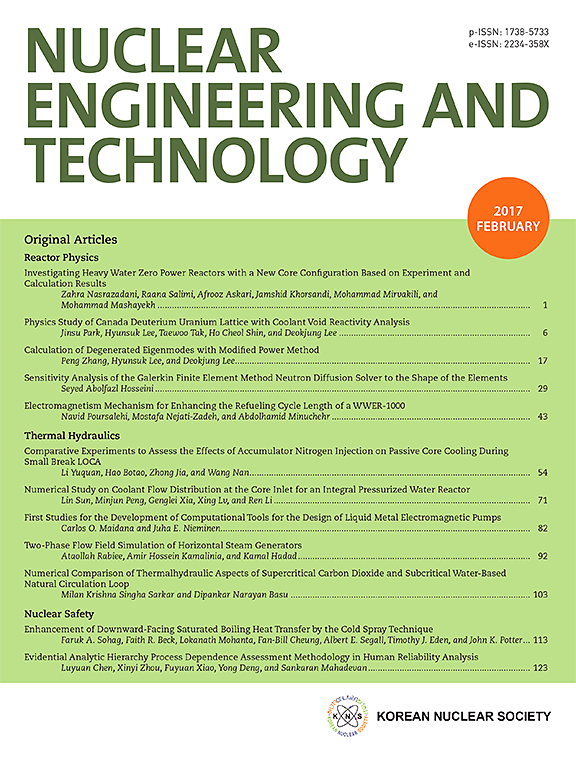热中子通量对硼酸盐和硅酸盐玻璃的影响:对所产生同位素的分布、衰变周期和吸收剂量率的实验和理论研究
IF 2.6
3区 工程技术
Q1 NUCLEAR SCIENCE & TECHNOLOGY
引用次数: 0
摘要
Bi2O3、CdO 和 Y2O3 等重金属氧化物增强了硅酸盐和硼酸盐玻璃样品的伽马射线屏蔽性能。目前的工作旨在通过实验研究这些硼酸盐玻璃和硅酸盐玻璃在暴露于热中子流时的性能。利用一个核研究反应堆,用 1.73 和 12.10 MGy 之间不同剂量的热中子辐照所制造的玻璃。此外,在 1 至 7 天的不同辐照时间内,IVV-2M 反应堆干通道内的热中子流在 2.27E+17 和 15.86E+17 中子/平方厘米之间变化。然后,利用伽马射线光谱仪检测辐照玻璃的放射性浓度,并确定在制造的玻璃中产生的新同位素。此外,还利用蒙特卡罗模拟代码估算了辐照后 1 至 120 天内辐照玻璃样品的吸收剂量。研究表明,辐照后 80 天内,辐照样品的几乎所有活性都会分解。辐照样品的剂量率和放射性活度浓度的分解是由于玻璃样品中产生的主要放射性同位素 Ba-131 的寿命较短。本文章由计算机程序翻译,如有差异,请以英文原文为准。
Effect of thermal neutron flux on borate and silicate glasses: Experimental and theoretical investigation for distribution, decay period, and absorbed dose rate of produced isotopes
The gamma-ray shielding properties for silicate and borate glass samples were enhanced by heavy metal oxides such as Bi2O3, CdO, and Y2O3. The current work aims to study experimentally performance of these borate and silicate glasses experimentally when exposed to a flux of thermal neutrons. A nuclear research reactor was utilized to irradiate the fabricated glasses with various doses of thermal neutrons varied between 1.73 and 12.10 MGy. Additionally, the fluency of the thermal neutrons within the dry channel of the IVV-2M reactor containing the fabricated samples varied between 2.27E+17 and 15.86E+17 neutron/cm2 at various irradiation times between 1 and 7 days. After that, a gamma-ray spectrometer was utilized to detect the activity concentrations from the irradiated glasses as well as identify the new isotopes created within the fabricated glasses. Additionally, the Monte Carlo simulation code was utilized to estimate the absorbed dose from the irradiated glass samples over a time period between 1 and 120 days after the exposure. The study shows almost all of the activities of the irradiated samples decomposed over 80 days after irradiation. The decomposition of the dose rate and activity concentration for the irradiated samples are attributed to the short lifetime of Ba-131 isotope which represents the major radioactive isotope created within the glass sample.
求助全文
通过发布文献求助,成功后即可免费获取论文全文。
去求助
来源期刊

Nuclear Engineering and Technology
工程技术-核科学技术
CiteScore
4.80
自引率
7.40%
发文量
431
审稿时长
3.5 months
期刊介绍:
Nuclear Engineering and Technology (NET), an international journal of the Korean Nuclear Society (KNS), publishes peer-reviewed papers on original research, ideas and developments in all areas of the field of nuclear science and technology. NET bimonthly publishes original articles, reviews, and technical notes. The journal is listed in the Science Citation Index Expanded (SCIE) of Thomson Reuters.
NET covers all fields for peaceful utilization of nuclear energy and radiation as follows:
1) Reactor Physics
2) Thermal Hydraulics
3) Nuclear Safety
4) Nuclear I&C
5) Nuclear Physics, Fusion, and Laser Technology
6) Nuclear Fuel Cycle and Radioactive Waste Management
7) Nuclear Fuel and Reactor Materials
8) Radiation Application
9) Radiation Protection
10) Nuclear Structural Analysis and Plant Management & Maintenance
11) Nuclear Policy, Economics, and Human Resource Development
 求助内容:
求助内容: 应助结果提醒方式:
应助结果提醒方式:


